Introduction
Human resources are the heart of a business as they help the business to carry out its everyday activities and assist it to trade and serve the society; nevertheless, human resource management refers to the way in which such individuals are handled; so, HRM possesses a broader sense, as individuals are dissimilar from all other assets of the company. The reason behind this is that human resources possess contemplations, mind-sets, ambitions, and wants; as a result, the concept of human resource management considers the requirements of the business as well as the requirements of the workers; most importantly, the concept seeks to identify ways through which conflicting interests of the firms and its employees could be met elegantly.
In order to explore through the concept of human resource management effectively, it is highly important to understand the role of human resource management in the organization, and appreciate the significance of diversity and the business case, by keeping in mind the fair treatment for all, regardless of any protected classes (for example, gender, race, age, religion, and so on). In addition, it is also essential to explain and discuss the current trends in human resource management that persuade strategies and decisions, and summarize the most important laws that govern human resource management, as well as explaining the ways in which employers can alleviate the legal risk.
On the other hand, apart from analyzing all those concepts, this paper also assesses the elements of a job analysis and recognizes various methods of job designing, as well as analyzing the significance of job analysis and design in context of HR management and describing the processes for planning. In addition, this paper further assesses, describes, and applies the strategic model of human resource management and development by denoting their influences, which led to the improvement of the model; on the other hand, the paper has also focused on suggesting ways of involving and engaging staff while respecting the differences between them.
Later on, the paper has put forward apposite methods regarding how to adapt standard western models to the needs of particular organizations and countries, and considered HR management in the context of developing countries and transitional economies together with delivering pertinent conclusions.
Understanding the role of human resource management in organizations
Managing human resource is one of the most significant tasks in today’s organizations, and successful management of this resource could bring unbounded success in the business due to proper engagement of talents, skills, and elegance; therefore, it is highly important to understand the role of human resource management within different organizations throughout the corporate world.
To put simply, Bratton (2002) suggested that human resource management refers to the way in which the business of today’s world handles the issues of proper administration of manpower inside the corporation; moreover, majority of the organizations possess HR departments, which are held to be accountable for aptly dealing with individuals and exploiting them in a profitable, but ethical manner. In most of the cases, the human resource departments are responsible to perform the roles outlined and assessed in the table below:
Table 1: Assessing the role of human resource management.
Understanding the importance of diversity and the business case
In order to manage human resources efficiently, it is highly crucial to understand the significance of diversity in the businesses throughout the corporate world; particularly, it is essential to focus on the concepts of fair treatment towards the workforce, avoiding the privileges given to the protected classes, and ensuring justice for every race, religion, gender, age, and so on. According to Banfield and Kay (2012), corporate diversity is an ample notion to embrace every person irrespective of their tribal upbringing by synchronizing equitable orthodoxy schema through engendering workplace ambiance and corporate attachment; in addition, the authors also stated that diversity involves revering natives joining from unusual upbringing and observing reunion of many cultures through marked standpoints as a whole.
Moreover, Banfield and Kay (2012) further pointed out that diversity could be present in fields of individual distinctiveness, backdrop, rituals, nature, functioning styles, faith, accent, tongue, an so on; on the other hand, in order to protect diversity within firms, the anti discriminatory laws cover people against taunts motivated by ethnic, sexual, marital, religious, parenthood, and skin color related issues. However, Bell (2011) has beautifully pointed out the significance of diversity in the firms of the business world, which has been briefly outlined in the table below:
Table 2: Importance of diversity in the business.
Discussion on current trends of HRM that influence strategy and decisions
In the rapid pace of globalization, the businesses around the world are focusing on reforming and restructuring their respective traditional strategies and decisions and adopting new and innovative schema to better handle and efficiently manage human resources. As a result, the current trend of human resource management has significantly influenced the strategies and decisions of the business organizations all through the world. However, at this stage, it is important to state that Albu and Moroşan-Dănilă (2009) identified a range of trends that were noted from the business organizations throughout the world in the recent years. The trends of human resource management recently adopted by the businesses and the resulting impacts on the strategies and decisions are briefly considered below:
Table 3: Current trends of HRM.
Major laws governing HRM and how employers can mitigate legal risk
The Occupational Safety and Health legislation, Fair Labor Standards Act, Labor Management Reporting and Disclosure legislation, employee protection laws, Employee Retirement Income Security legislation, and workers’ compensation laws are the major laws governing HRM in the United States; however, every country possesses particular laws to oversee HRM practices; so to mitigate legal risk, employers should deeply comply with the rules.
The elements of a job analysis and the various methods of job designing
According to Woods (2012) job analysis refers to a comprehensive manifestation of a precise post or post categorization; to be specific, this recognizes the responsibilities carried out the worker on specific post, as well as the acquaintance, expertise, aptitudes, and individual features wanted to execute the responsibilities; conversely, a decisive portion is to converse with specialists to categorize main responsibilities.
In addition, job analysis requires certification of necessary purposes, specification of precise necessities, comprehensions, dexterities, and capabilities needed to conduct the indispensable works; however, Woods (2012) also noted that job analysis could offer information for large number of HR behaviors relating a specified post categorization, as well as cataloging, disburse, employment, assortment, preparation, expansion, performance assessment, work adjustment, and HR-scheduling.
On the other hand, Woods (2012) noted that job analyses are carried out to attain precise, contemporary, and dependable data regarding posts to better appoint and better administer management-decisions; as part of the selection-procedure, this gives managers chance to develop thorough and lucrative employment decisions; it is the best way to find out the most suited worker for the post. The figure below shows that the key elements of a job analyses comprise job description and job specification, which in addition includes employment and selection strategies, performance assessments, job assessments, salary decisions, as well as worker edification necessities:
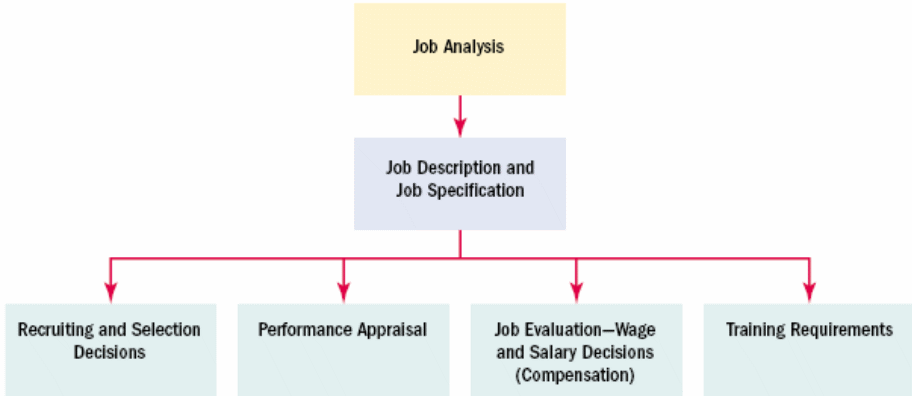
Parker and Ohly (2007) pointed out that various techniques exist through which the corporate leaders perform the job designing activity; these consist of work oversimplification, work rotation, work enlargement or extension and work enrichment or enhancement; for example, under work oversimplification technique, the entire task is split into tiny sub-divisions that do not necessitate a large amount of expert supervision. The technique of work rotation indicates the act of changing the workers from one task to the other in the operational assembly in order to ensure that the workers are not jaded doing one simple task over and over again and they get some level of job satisfaction by enjoying the variety in the workplace.
In addition, Parker and Ohly (2007) also pointed out that the techniques of work enlargement at the business organizations indicate the act of flatly augmenting working practices insides the company; work enlargement is carried out by placing the workers to the posts or assignments carried out by the workers at the same level.
On the other hand, the authors have also noted that another very essential method of designing job is to carry out work enrichment activities; however, it is notable that enrichment is a motivational method where the substance, extent, or exploration of the work is amplified or improved; however, the job is sometimes enriched by accumulating works from other managerial ranks. However, the figure below briefly illustrates the motivational effects and other benefits that the firms attain after carrying out and applying apt of job design methods throughout the business units.
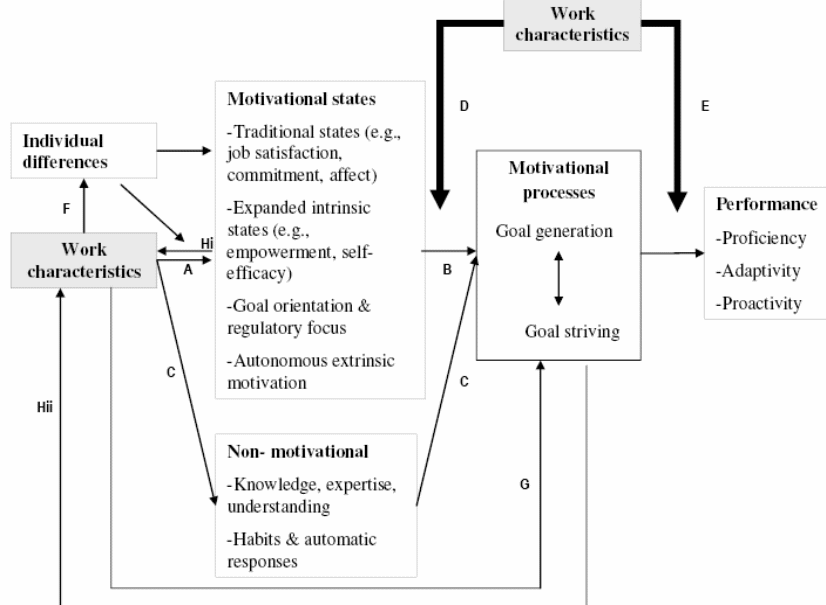
The significance of job analysis and design to human resource management
Torraco (2005) has pointed out that it is highly essential for organizations to appreciate the significance of job analysis and job design in order to apply properly the techniques and attain success; however, to denote particularly, job analysis is significant because it gives immediate work related information, assisting administrators to handle the human resources skillfully. In addition, job analysis assists manager to make accurate posting and placement of the workers, fitting the correct worker in the correct place by means of assessing their expertise, indulgence, and proficiencies through apt examinations; moreover, job analysis aids the boss to recognize what kind of worker would be apposite to convey the precise task fruitfully.
Torraco (2005) has also suggested that job analysis assists in creating effectual appointing activities, directs through performance assessment and evaluation procedure, aids in investigating training and progress requirements, assists in resolving reimbursement package, and so on; however, the key significance of job analysis has been demonstrated in the figure below:
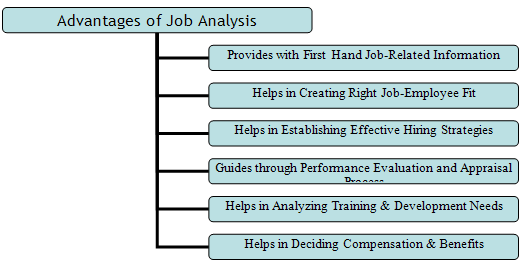
The concept of job design, on the other hand, has a great level of significance in organizational practices as it helps worker to discover innovative abilities, to lessen tedium, to obtain gratitude, to inspire member of staff, and to develop human resource involvement in the firm from an overall perspective as well. In addition, a huge number of researchers suggest that job designing helps a firm to increase productivity output and efficiency, and assist human resources not just to complete their respective tasks swiftly and successfully, but also to enhance the operational satisfaction both in terms of worker engagement and in terms of better yield for the firm.
Thus, as Arthur (2004) notes, by adopting smart job analysis and job designing methods, firms could lower costs that results from delay, absenteeism, and mistaken tasks and charge smaller amounts from the end consumers; it is notable that such a practice helps the firm to sale more items at affordable prices, making the firm able to attain economies of scale.
The processes for Human Resource Planning (HRP)
HRP is the procedure of forecasting future HR requirements; at the initial stage, the management team of the companies will assess the demand of the employees to serve the customers and estimate the internal inventory (Pathak, 2009; and PSNACET 2012); however, the following figure shows the processes for HRP:
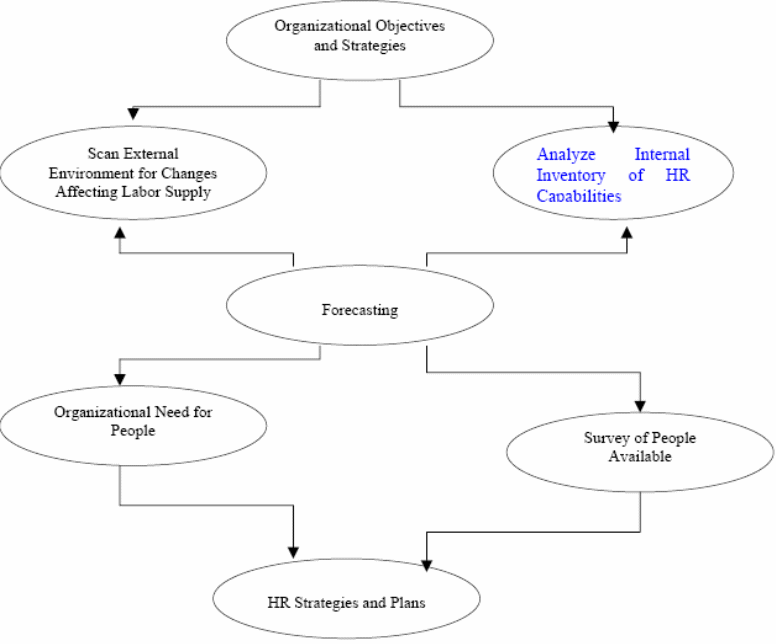
Table 4: HRP processes.
The strategic model of human resource management
Chowdhury (2012, p.24) provided a strategic model for the HRM, which includes five major steps, such as, environmental context, mission and vision of the company, organizational strengths and culture, study of strategies, select and execution of the HR strategies; however, the following figure shows the strategic model of HRM:
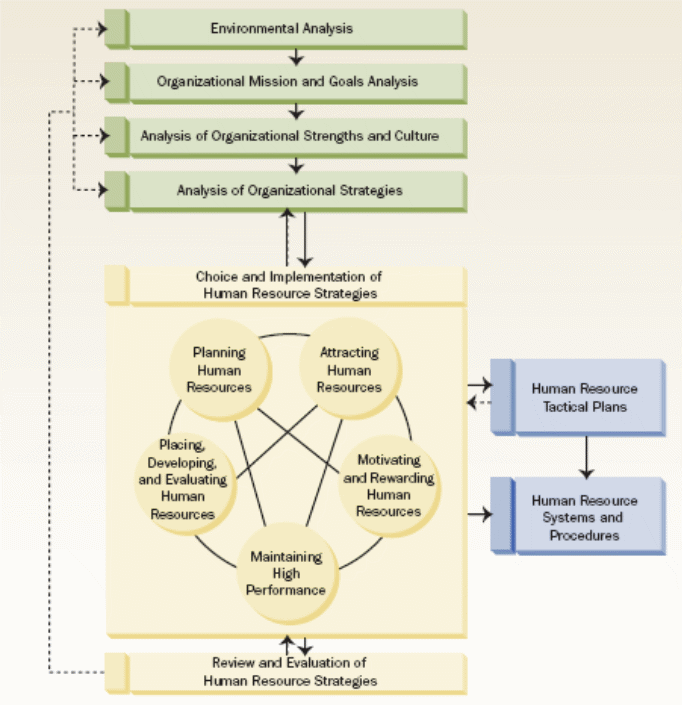
Table 5: The strategic model of HRM.
The HR managers should prepare job analysis report to collect important information regarding responsibility and performance standards to meet the demand of the employees, implement HR strategies and training planning (Krishnan & Singh 2012; Mello 2001; and Chowdhury 2012, p.28). At the same time, the HR managers will meet all legal requirements in order to recruit workforce, such as, employment laws, action policies, regulation, and derivative; in this case, the managers will try to attract a pool of high-quality candidates and select most potential candidates using a series of specific steps (Krishnan & Singh 2012; and Chowdhury 2012, p.29).
The top management team should recommend the HR managers to organize training programs for the new members since the new workers need to know about job responsibilities, organizational culture and policies to prepare them for the future responsibilities and to perform effectively (Krishnan & Singh 2012; Mello 2001; and Chowdhury 2012, p.29). However, the companies will provide compensation with other benefits to the competent employees to motivate the staff and to maximize performance (Krishnan & Singh 2012; Mello 2001; and Chowdhury 2012, p.29). In addition, HR strategy should design concentrating on the productive contribution from every member for which it needs to develop well-established employee relations practices (Krishnan & Singh 2012; Mello 2001; and Chowdhury 2012, p.29).
On the other hand, Krishnan & Singh (2012) provided three-stage model of SHRM, which mainly focused on the formulation & translation, implementation, and evaluation; however, the main features of this model can be illustrated through the following figure:
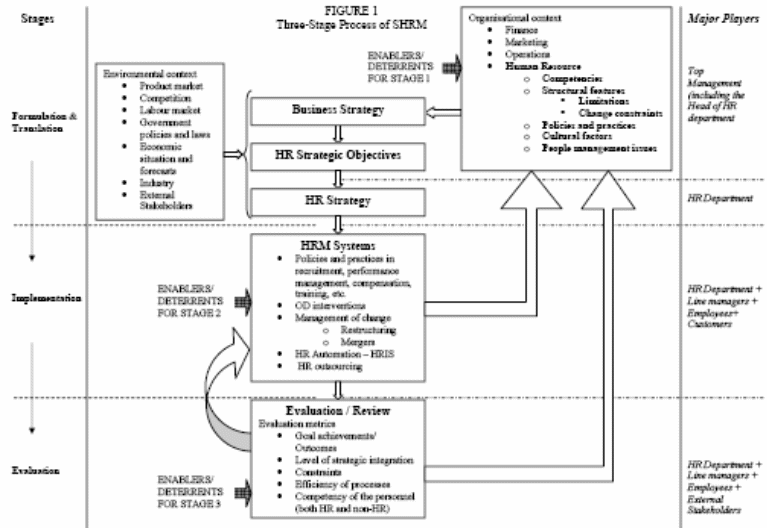
Development and the influences of the strategic model of HRM
Chowdhury (2012, p.24) identified the trends of the development and stated that the workers of the companies have shared their views and personal problems with other members of the organization, for instance, living style, medical assistance, job satisfaction, workload, and so on. However, the competition among the companies increased over time due to the effect of globalization; therefore, the companies initiate to use all resources including human resources to sustain in the competitive market; thus, HRM becomes an important part of strategic management (Budhwar & Aryee 2008; Krishnan & Singh 2012; Milikić & Janićijević 2008; Chowdhury 2012 and Mello 2001). At the same time, the concept of SHRM is still developing to enhance the performance of the companies in the global market
Suggested ways of involving staff while respecting differences between them
It is vital to state that staff involvement within the firm cannot be ensured unless the managers and executives learn to respect the differences and diversities between workers; as a result, it is crucial for a firm to avoid racial practices if it wants to retain and ensure staff involvement. However, apart from unbiased diversity management, it is also important to suggest the firms a number of ways in which they can boost staff involvement; some of these are outlined in the table below:
Table 6: Suggested ways of involving staff.
How to adapt standard ‘Western’ models
Ahlstrom, Foley, Young & Chan (2005) and Raman (2013) stated that the Western model of HRM derived from individualism, promise and a unitary approach; however, Pudelko & Harzing (2009) argued that most of the Chinese and Japanese firms have tried to incorporate standard ‘Western’ models in some extent considering the liberal approach of this model.
However, the developing countries and transitional economies have changed their policies in accordance with the provisions of WTO because multinational companies enter in the emerging markets considering different entry mood strategies; at the same time, local companies start the business with foreign companies (Shi 2010; and CAHRS 2010). However, the management of the multinational companies had tried to adapt standard ‘Western’ models for which they emphasis on change the mentality of the employees since they fear with penalty system for doing anything outside of their job descriptions. (Shi 2010; and CAHRS 2010).
Table 7: Comparison among different models.
HRM in the developing countries and transitional economies
The governments of developing countries and transitional economies have tried to change the national economy by taking and implementing different strategies and projects, for instance, liberalize the market, focus on privatization, and develop the performance of the public organizations for stimulating and accelerating economic development (Okpara, 2008, p.3). According to the view of Law, Tse & Zhou (2002), the HRM practice in the developing countries and transitional economies based on the performance of the local institutions, for instance, powerful social institutions in a transitional economy can introduce effective HRM practice.
On the other hand, the political factors and the framework of the governments have influenced the conceptual framework of HRM in the developing countries and transitional economies (Okpara, 2008; Thite, Wilkinson & Shah, 2013; Sparrow, 2011; and Law, et al. 2002). However, model and size of the firms along with effective leaders play vital role to improve HR systems while HR practices enhance organizational performance; unfortunately, the companies in the developing countries faced problems related with the shortage of capable management talent, dissatisfaction and high staff turnover rate (Okpara, 2008; and Thite, et al., 2013).
Therefore, the leaders of multinational companies in these regions have to focus more on the HRM issues; however, most of the companies emphasized on the best leadership approach to overcome the HRM problems and sound HR practices to develop and sustain (Okpara, 2008; Thite, Wilkinson & Shah, 2013; and Sparrow, 2011). At the same time, it is important to note that the employees of many developing countries become depressed for many uncertain and risk factors; therefore, efficient leaders are playing crucial role to develop good HRM system and to carry out organizational functions by minimizing such risks (Okpara, 2008; Thite, Wilkinson & Shah, 2013; and Law, et al. 2002).
Developing countries and transitional economies, such as, China, Slovenia, Serbia and many others have already introduced undergraduate and graduate courses, formal and informal education and training programs for HR professionals with intent to develop business competence, professional-technical knowledge and to get skilled and educated employees (Milikić & Janićijević 2008). However, the managements of the multinational companies still ignore many issues to adopt effective HRM systems while these firms operate in the developing countries, for example, recruitment process, compensation policy, career plan, supervision personal files, ensure legal concerns, and employee development are rather abandoned and underdeveloped (Milikić & Janićijević 2008; and Okpara, 2008).
At the same time, most of the companies in these countries are not aware about the importance of effective HR systems to gain competitive advantages; they mainly focus on the complex and imperative problems for instance acute financial crisis, technological barriers, competition and so on (Milikić & Janićijević 2008; Okpara, 2008; Thite, Wilkinson & Shah, 2013; and Law, et al. 2002).
On the other hand, most of the companies in these countries have focused on the autocratic leadership approach and a high degree of centralization for which top managers are responsible for policy consideration where the employees have no participation on the strategic decision-making process (Milikić & Janićijević 2008; Okpara, 2008; Thite, Wilkinson & Shah, 2013; and Law, et al. 2002).
Conclusion
From the above reasoning, it could be suggested that the firms need to engage human resources from dissimilar communal backgrounds; however, the administrative side simultaneously needs to move violently for managing and smartly handling these miscellaneous cultures and views in workplaces, as well as motivating them towards a good engagement with the company in order to attain a better outcome.
As a result, this research paper has evaluated different issues relating to HR management throughout the discussion and tried to find out ways in which future administrators could better deal with complex cultures and yield higher profits not just in terms of money, but also in terms of lower turnover rate, better performance, higher motivation, and lesser costs of production. Certainly, effective human resource management could result in unbounded success for the corporation from all spheres; it could also bring about greater job satisfaction, and boost ethical trading by valuing worker’s efforts and ensuring fair treatment.
Reference List
Ahlstrom, D. Foley, S. Young, M. N. & Chan. E. (2005). Human Resource Strategies in Post-WTO China. Web.
Albu, O. & Moroşan-Dănilă, L. (2009). Current trends in HRM. The Annals of the Ştefan cel Mare University of Suceava, 9(2), 134-139.
Arthur, D. (2004). Fundamentals of Human Resources Management. New York, the USA: AMACOM.
Banfield, P. & Kay, R. (2012). Introduction to Human Resource Management. Oxford, the UK: OUP.
Bell, M. P. (2011). Diversity in Organizations. Ontario, Canada: Cengage Learning.
Bratton, J. (2002). Strategic human resource management. Web.
Budhwar, P. & Aryee, S. (2008). An Introduction to Strategic Human Resource Management. Web.
CAHRS. (2010). A China-based High-Performance HR System: A Model for Success. Web.
Chowdhury, S. (2012). The strategic human resource management model. Web.
Hollenbeck, J., Gerhart, B., Wright, P. & Noe, R. A. (2012). Human Resource Management: Gaining a Competitive Advantage. New York, the USA: McGraw-Hill.
Krishnan, S. & Singh, M. (2012). Strategic Human Resource Management: Three-Stage Process and Influencing Organisational Factors. Web.
Law, K. Tse, K. & Zhou, N. (2002). Does human resource management matter in a transitional economy? – China as an example. Web.
Mello, J.A. (2001). Strategic Human Resource Management. Cincinnati: South Western.
Milikić, B. & Janićijević, N. (2008). HRM Trends in Transition Economies: Two Reflections of the Shared Background. Web.
Okpara, J. O. (2008). Human resource management practices in a transition economy: Challenges and prospects. Web.
Parker, S. K. & Ohly, S. (2007). Designing Motivating Jobs. Web.
Pathak, S. (2009). Describe the process of Human Resource planning. Web.
PSNACET. (2012). Human Resource Planning: Process, Methods, and Techniques. Web.
Pudelko, M. & Harzing, A. (2009). Japanese Human Resource Management: Inspirations From Abroad And Current Trends Of Change. Web.
Raman, M. (2013). Is There One Right Way To Manage HR?. Web.
Shi, W. (2010). HR Practices and Challenges in Chinese Firms: Comparison with Western Firms. Web.
Sparrow, P.R. (2011) Managing HR for Organizational Performance. Web.
Thite, M. Wilkinson, A. & Shah, D. (2013). Internationalization & HRM Strategies across Subsidiaries in Multinational Corporations from Emerging Economies – A Conceptual Framework. Web.
Torraco, R. J. (2005). Work Design Theory: A Review and Critique with Implications for Human Resource Development. Web.
Woods, R. H. (2012). Job Analysis and Job Design. Web.